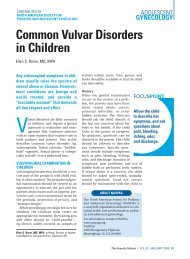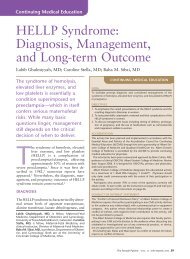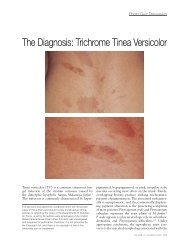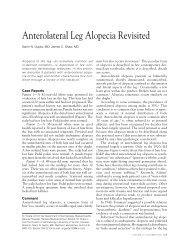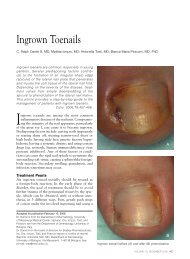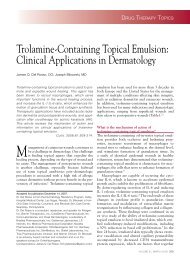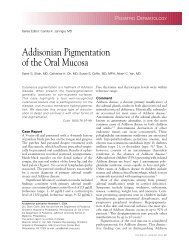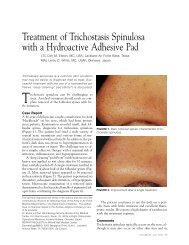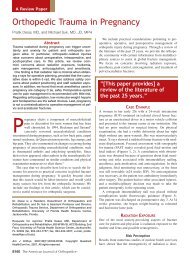External Genital Warts: An Update
External Genital Warts: An Update
External Genital Warts: An Update
You also want an ePaper? Increase the reach of your titles
YUMPU automatically turns print PDFs into web optimized ePapers that Google loves.
Mayeaux<br />
Key Points<br />
• Human papillomavirus (HPV) infection<br />
can cause a spectrum of diseases ranging<br />
from nonmalignant skin growths<br />
to epithelial dysplasias and cancers.<br />
• HPV infects the nuclei basal layer of<br />
epithelial cells, where it usually exists<br />
for about 3 months in a latent state.<br />
• The majority of anogenital HPV infections<br />
are subclinical.<br />
• There are no readily available clinical<br />
diagnostic methods to identify subclinical<br />
infections.<br />
• Imiquimod, podophyllin, and podofilox<br />
are contraindicated in pregnancy.<br />
• Interferon therapy is not recommended<br />
as a primary modality<br />
because it is inconvenient, ineffective,<br />
and associated with a high frequency<br />
of systemic adverse effects.<br />
• Cesarean delivery should not be performed<br />
solely to prevent HPV transmission<br />
to the newborn.<br />
• The use of a cryoprobe in the vagina<br />
is not recommended because of the<br />
risk of vaginal perforation and fistula<br />
formation.<br />
• Patients with warts on the anal<br />
mucosa should undergo digital rectal<br />
examination or anoscopy to detect<br />
rectal warts.<br />
<strong>Genital</strong> warts in women may develop<br />
anywhere in the squamous epithelium of the<br />
lower genital tract, and multiple sites are<br />
found in about 50% of patients. 3 Although<br />
such warts are often asymptomatic, some<br />
patients may experience anogenital pruritus,<br />
burning, vaginal discharge, and/or bleeding.<br />
Rarely, dyspareunia or obstruction of the<br />
urethra, vagina, or rectum may occur.<br />
Human papillomavirus primarily infects<br />
the basal layer of epithelial cells. It usually<br />
exists in a latent state for about 3 months.<br />
The virus replicates in dividing epithelial<br />
cells, eventually producing genital warts.<br />
The majority of anogenital HPV infections<br />
are subclinical, and are identified only by<br />
whitening on application of 5% acetic acid<br />
(acetowhite effect), or a finding of HPV<br />
DNA without associated epithelial abnormalities.<br />
There are no readily available,<br />
specific clinical diagnostic methods for<br />
identifying subclinical infections.<br />
TRANSMISSION<br />
Prior or coexisting HPV<br />
infection does not affect<br />
the risk of acquiring new<br />
HPV infections. Risk is most<br />
strongly associated with sex<br />
with a new partner—ie,<br />
exposure to new strains. 4<br />
Although vaginal intercourse<br />
is the predominant mode of<br />
transmission, HPV may also<br />
be transmitted through nonpenetrative<br />
sexual contact (eg,<br />
in virgins). 4<br />
Contrary to traditional<br />
thinking, male condom use<br />
can reduce the risk of maleto-female<br />
transmission<br />
by 70%. 5 Other risk factors<br />
include current smoking<br />
and oral contraceptive<br />
(OC) use, which may be<br />
surrogate markers for other<br />
sexual behaviors. 4 Use of the quadrivalent<br />
HPV vaccine may decrease the risk of external<br />
HPV lesions when administered prior<br />
to exposure.<br />
VIRAL TYPES<br />
The majority<br />
of anogenital<br />
HPV infections<br />
are subclinical,<br />
and are identified<br />
only by whitening<br />
on application<br />
of 5% acetic<br />
acid (acetowhite<br />
effect), or a<br />
finding of HPV<br />
DNA without<br />
associated<br />
epithelial<br />
abnormalities.<br />
More than 30 HPV types can infect the<br />
human genital area. 6 <strong>An</strong>ogenital HPV types<br />
are subdivided based on oncogenic risk.<br />
High-risk types (eg, 16, 18, 31, 33, 35)<br />
are strongly associated with cervical neoplasia.<br />
They usually cause flat lesions that are<br />
only identified on Papanicolaou smear or<br />
The Female Patient VOL. 32 DECEMBER 2007 39



